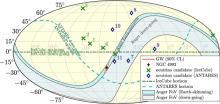
Abstract
The Advanced LIGO and Advanced Virgo observatories recently discovered gravitational waves from a binary neutron star inspiral. A short gamma-ray burst (GRB) that followed the merger of this binary was also recorded by the Fermi Gamma-ray Burst Monitor (Fermi-GBM), and the Anticoincidence Shield for the Spectrometer for the International Gamma-Ray Astrophysics Laboratory (INTEGRAL), indicating particle acceleration by the source. The precise location of the event was determined by optical detections of emission following the merger. We searched for high-energy neutrinos from the merger in the GeV--EeV energy range using the ANTARES, IceCube, and Pierre Auger Observatories. No neutrinos directionally coincident with the source were detected within ±500 s around the merger time. Additionally, no MeV neutrino burst signal was detected coincident with the merger. We further carried out an extended search in the direction of the source for high-energy neutrinos within the 14-day period following the merger, but found no evidence of emission. We used these results to probe dissipation mechanisms in relativistic outflows driven by the binary neutron star merger. The non-detection is consistent with model predictions of short GRBs observed at a large off-axis angle.